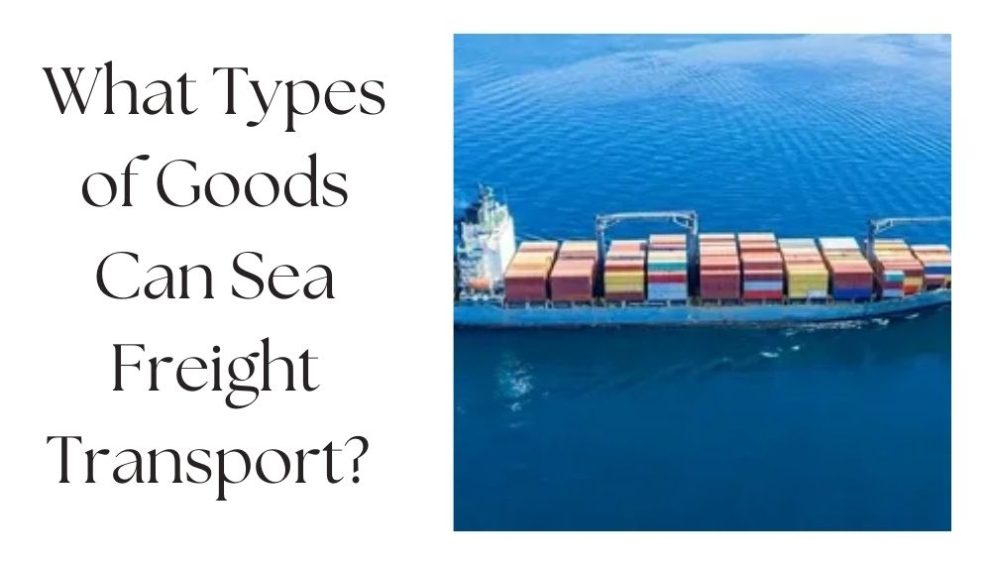What Types of Goods Can Sea Freight Transport?


Introduction
Sea freight is one of the most widely used methods of transporting goods across international borders. It plays a crucial role in global trade by enabling businesses to move large quantities of goods efficiently and cost-effectively. Moreover, the versatility of sea freight services allows it to accommodate a wide range of goods, from raw materials to perishable items. Understanding the types of goods transported via sea freight helps businesses make informed logistics decisions and choose the appropriate shipping methods.
Moreover, sea freight continues to be a preferred choice for global trade due to its cost-effectiveness and capacity to handle diverse cargo types. In addition, advancements in tracking and security have improved reliability, ensuring safer shipments. As a result, businesses can optimize their logistics while benefiting from efficient and scalable transportation solutions.
Bulk Cargo and Raw Materials
Bulk cargo consists of large quantities of unpackaged goods transported in bulk carriers. This type of cargo is further classified into dry bulk and liquid bulk, depending on the nature of the materials being shipped.
Dry Bulk Cargo
-
Dry bulk cargo refers to commodities that businesses transport in large quantities without packaging. Shippers load these materials directly into the cargo hold of a vessel, making them essential for manufacturing and construction industries.
- Grains and Agricultural Products: Shippers frequently transport wheat, corn, rice, soybeans, and other staple crops via sea freight to meet global demand.
- Metals and Minerals: Companies ship coal, iron ore, aluminum, copper, and other minerals in bulk to support industrial production.
- Cement and Building Materials: Industries move cement, sand, and gravel in bulk to meet the demands of construction projects.
- Chemicals and Fertilizers: Manufacturers rely on sea freight to transport industrial chemicals, fertilizers, and other essential materials for agriculture and production.
Liquid Bulk Cargo
- Liquid bulk cargo consists of liquids transported in large quantities using specialized tankers. These shipments require careful handling and monitoring due to their nature.
Oil tankers transport crude oil, gasoline, diesel, and other petroleum products across the world. Chemical tankers, equipped with specialized storage facilities, ship industrial chemicals, including acids, solvents, and resins. Large quantities of wine, fruit juices, vegetable oils, and other liquid consumables reach international markets through bulk transportation.
Containerized Goods
Container shipping is one of the most efficient methods of transporting goods via sea freight. Notably, it ensures better security, ease of handling, and cost savings for businesses shipping various types of products.
Consumer Goods and Electronics
Consumer goods and electronics constitute a significant portion of containerized shipments, typically transported in standard 20-foot or 40-foot containers.
Retailers and manufacturers receive apparel, footwear, and fabrics through global shipping. Specialized containers transport smartphones, televisions, laptops, refrigerators, and washing machines to prevent damage.Beds, tables, chairs, and home accessories are carefully shipped with protective packaging to prevent breakage. Likewise, automotive and machinery parts are securely transported to ensure safe delivery.
Automotive and Machinery Parts
The automotive industry heavily relies on sea freight to ship cars, motorcycles, and industrial machinery. Specialized containers and carriers ensure the safety of these valuable goods.
Specialized vehicle carriers or containerized shipments transport cars, motorcycles, and their spare parts. Heavy-lift vessels ship construction equipment, agricultural machinery, and industrial tools securely.
Food and Perishable Goods
Sea freight also transports perishable items using specialized containers with refrigeration and controlled environments to maintain freshness.
Reefer containers transport frozen fish, meat, and dairy products. Temperature-controlled containers ship bananas, apples, and citrus fruits. Specific temperature settings preserve the freshness of milk, cheese, and yogurt during transportation.
Hazardous and Dangerous Goods
Shipping hazardous goods requires strict adherence to international safety regulations. These goods must be handled with care and transported in specialized containers to prevent potential risks.
Chemicals and Industrial Hazardous Materials
Shippers transport hazardous chemicals, including corrosive, toxic, or flammable substances, under strict safety protocols.
They carefully transport fireworks, gasoline, and certain chemicals while complying with international safety standards. Secure containers prevent contamination when shipping pharmaceuticals, radioactive substances, and industrial chemicals.
Pharmaceuticals and Medical Supplies
The healthcare industry heavily relies on sea freight to ship essential medical products. Moreover, these goods require strict temperature and handling conditions to ensure their effectiveness.
Controlled environments facilitate the shipment of many non-urgent pharmaceuticals, including medicines and vaccines. Additionally, shippers transport hospital beds, surgical instruments, and laboratory devices worldwide to meet healthcare demands.
Project Cargo and Oversized Goods
Certain types of cargo require specialized vessels due to their size and weight. These include large industrial and infrastructure-related shipments, which demand customized shipping solutions.
Additionally, sea freight plays a vital role in connecting global markets by providing an efficient and scalable shipping solution. Not only does it accommodate bulk shipments and containerized goods, but it also ensures cost savings compared to other transport modes. Furthermore, improved logistics technologies, such as real-time tracking and secure handling, have enhanced the reliability of sea freight. As a result, businesses can confidently expand their supply chains, ensuring smooth and timely deliveries across international borders.
Construction and Infrastructure Equipment
Sea freight commonly transports large equipment for major infrastructure projects.
Steel structures, prefabricated buildings, and bridge components reach construction sites through shipping. Solar panels, wind turbines, and hydroelectric equipment are transported worldwide for energy projects.
Military and Defense Equipment
Military equipment, including armored vehicles, weapons, and defense technology, is shipped securely under government regulations.
- Tanks and Military Vehicles: These require specialized carriers for secure transport.
- Ammunition and Defense Supplies: Strict safety and security protocols are followed when shipping these goods.
Conclusion
Sea freight is an essential mode of transportation for a diverse range of goods. From raw materials and consumer products to hazardous chemicals and oversized project cargo, the shipping industry provides secure and cost-effective solutions for businesses worldwide. By choosing the right shipping method and container type, companies can optimize their logistics operations and ensure the safe and efficient delivery of their products. As global trade continues to expand, sea freight will remain a vital component of international commerce, offering reliability, flexibility, and scalability for businesses of all sizes.
Furthermore, sea freight remains a crucial component of international trade, offering businesses a cost-effective and scalable solution for transporting a wide range of goods. In addition to its affordability, it provides flexibility in shipping both bulk commodities and containerized goods, making it an ideal choice for industries worldwide. Moreover, with advancements in logistics technology, companies now have access to real-time tracking, ensuring greater transparency and security throughout the shipping process. As a result, businesses can efficiently monitor their shipments, anticipate potential delays, and optimize their supply chains accordingly. Additionally, the ability to transport hazardous materials, pharmaceuticals, and oversized cargo further underscores the versatility of sea freight. Not only does it support economic growth by facilitating trade across continents, but it also contributes to the sustainability of logistics by accommodating eco-friendly shipping practices. As global commerce expands, sea freight remains indispensable in the supply chain, ensuring the safe, efficient, and cost-effective transportation of goods.
For More Insightful Articles Related To This Topic, Feel Free To Visit: bloggingshub.com













